Robert Exter
The UNABOM Artist's Manifesto
A True Story
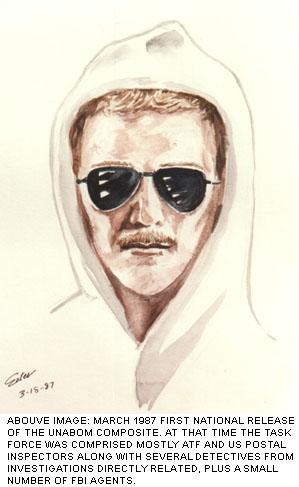
If you're interested in this very small field of art, and what it might be like to be a police artist, you'll surely get an eyeful on this webpage. To the left is the 1987 composite of the Unabomber that was painted with watercolors for the Salt Lake City witness by yours truly. Unfortunately it was not effective enough to bring Ted Kaczynski in before he killed two more people. The Unabomber was the FBI's most wanted terrorist of the 1970's, 80's, and 90's. I suppose it was a chance to prove myself, but it turned out to be a course in advanced identification artwork strategy; “how to do it right the next time”.
The sunglass reflection is something that I copied from a Polaroid snapshot taken through the same blinds that the witness caught Kaczynski's attention through. I wanted to create what the witness actually viewed, so I requested that a detective pose in the same exact spot, time of day, wearing jeans, a hooded sweatshirt, and aviator sunglasses. In the later 1994 remake, I saw the same effect drawn into the glasses, but with not the same reflection. The bright reflections seen here in the 1987 composite are the most accurate of the two composites. You might say that it doesn't matter, but you should always try to be as accurate as possible. The job description of a Police Artist is to recreate what the witness describes as best you possibly can.
Even though I worked with the witness for several days, one thing that I learned in this case is that I should have put more time into the interview and maybe the visualization of Kaczynski's 'Popeye chin' would have come to the witness's memory. I have done much better on prior cases that I was able to complete in a few hours, but in the Unabom case, it took me days to work out the likeness. Identity traits that I was not able to extract from the witness's memory were the bushy auburn hair, showing too much forehead (meaning a lower hair line), and of course Kaczynski’s Popeye chin.
This is one of the most difficult composites that I ever faced in my experience as a police artist, and to set the record straight, I'm not writing this story about it's success, which is quite undetermined because I have never asked Ted Kaczynski, the convicted Unabomber, if he ever was influenced by the 1987 composite release. The only possible part it could have played is that, after being spotted placing a pipe bomb under a parked car, Kaczynski disappeared for a six year period; which must mean that being spotted made him decide to take a break and re-think his strategy. It is a fact that when he reappeared, his bombs were more effective and he sent them only by mail, never to plant one personally again.
I had been selected for this job not only because my composite drawings had been extremely accurate, or that the witness requested an artist who could put color to the Unabomber's hair, but mainly because Unabomber's first victim was killed in Sacramento; Hugh Scrutton, a computer store owner in the Sacramento's North Area off of Arden Fair Blvd. Being a portrait artist by trade, painting a composite in color wasn't a difficult request. I drew and painted family portraits in pastel, watercolor, and sometimes in oil paints. In this work you sometimes have a more difficult task of working from old faded photographs, some with torn or lost areas, and at times I have to request the help from a family member with a memory to confirm my concepts. This is much like the field of composite artist.
I can understand how some investigators might think that police composite art isn't effective, but I must say to them that they are just a victim of not having someone at hand capable enough to prove them wrong. So maybe before we get into the Unabom mix-up, I should prove to you that composites can be useful; very useful. I think that if the artist is good, and the witness is good, when time is a factor you can claim that an effective composite will save a life. One such case occurred in Sacramento in 1978, with the Dracula Killer.
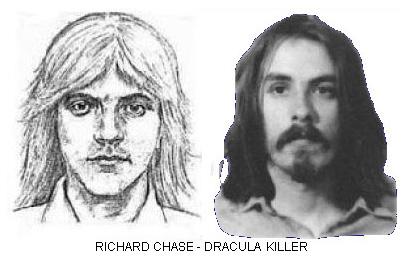
The Dracula Killer was a man named Richard Chase, who had been in mental hospitals prior to his rampage. The investigation started with a stabbing of a pregnant woman at her front door. This happened on a Monday. The Sacramento Sheriff deputies immediately sprang into action searching the general area around where the homicide occurred. Ray Biondi, Sacramento's top homicide investigator believed in using the public as much as possible. A couple months earlier I had introduced myself to Biondi, and had only done a couple of jobs, but in this I had proven myself useful by providing a very accurate composite solving some forty-five counts of armed robbery. However it was an easy job, being that the robber looked too much like a celebrity that everyone knew. The composite had been put on the news, and there were only 28 calls responding to the composite appearing in the newspapers and television news casts, three being from the robber's own family. It took one day from the composite release to make the arrest. And so, I was already famous to the Sacramento Sheriffs Department when the Chase murders started.

Getting back to Richard Chase, the Dracula Killer; Biondi had asked the public to report anything strange. On Thursday, three days after the first reported murder, a woman witness came forth saying that she had answered the door to a man with a gunny sack. Luckily her husband was near and ended up chasing the man away from the house, probably saving his wife's life. That night she gave me a description seen through a screen door. Time is very important in cases such as with Chase because on the next weekend Chase entered a house and killed four more people, and also abducted a baby. The composite played an important part when someone who lived near Chase saw the composite laying face up in a Sheriffs vehicle, and shortly there after notified the authorities. Even so, in a short period of time, six people were murdered. If you want to be critical of the Chase drawing, the mug shots were prior to the sighting. Chase did not have a goatee when seen through the screen. With composites you are dealing with many factors like lighting, obstacles, distance, and the witness's eyesight and memory. When Chase was arrested, he had shortened his hair to disguise his looks. However the composite worked as he was identified through prior mug shots. It took 11 days to bring him in. There is a book on the Dracula Killer by Ray Biondi.
Back in 1978, I had long hair myself. I was, and I still am, a free agent. This means that I am contracted just as I would be doing someone's private portrait. And really, I wasn't that popular with the Sheriffs looking like a hippy. But I loved art and had done my stretch in the USAF as a technician, a sergeant who worked on test equipment. After I was honorably discharged from the service and living in Sacramento, I also did a bit of work for the newspapers, anything to pay my bills. It was fun when I was young. So what I'm getting at is to tell you another story that I'm still a bit mad about, and I think it's important, and its how politics seems to play a part in our system; a part that it shouldn't play.
When I came to offer my services to authorities as a police artist, it was not because I needed the money; it was because I knew I could do better than what I had seen the department artist do. The drawings coming out of the Sheriffs department were so basic, and you could almost imagine anyone into the likeness. All it would take is a dislike for someone and he or she became the composite. This leads to many false leads (bogus leads) and a lot of investigative time wasted. I can agree with investigators discontented with lousy composites. When I introduced myself to Ray Biondi, he looked at my technical drawing skills and decided to use me around the department artist. It really was a good call because if you take note of my case solve rate, you'd know that with my artwork skills, it would only take a good witness to acquire a likeness good enough to reduce investigative time. Sure, even bad drawings can show a good detective physical differences needed to solve a case, but the better the artist, the better the job, which should mean a shorter time in solving the case; and that might be in time to keep a murderer from taking another life.
What happened to me is that the newspaper got wind that the composites coming out of the sheriff's department were solving cases. Unfortunately, the elected sheriff had the newspaper reporter interview the department artist instead of me. He didn't claim to have done my drawings, but left the public assuming he did. I still haven't calmed down over this shot in the back. This changed my good nature towards the department and I decided to move to Vancouver Island, Canada where my brother lived. It was beautiful there and I wanted to paint the ocean. So in July of 1979 I emigrated to Vancouver Island, BC. I carried with me a letter of accommodation written by Biondi, giving me credit for my police artwork. This is quite an unusual thing to have, an official letter saying your composites almost single handedly solving crimes. But do you think the RCMP would be interested? I guess I looked like a hippy to them too. But really, if I have to sell artwork, don't I have to look like an artist? Well life is life. I even had the top RCMP artist in Ottawa, a Sgt. Dunleavy, (See his letter) inventor of Canada's Identikit urging BC Identification headquarters to use me. They (the RCMP) never did, except once the local detachment tried, but the case I worked on wasn't important enough and was dropped. Finally though, I got a chance to work over the RCMP, redoing a composite in a major nation wide murder case in Abbotsford, BC. The case was called "the Abbotsford Murder Case" and was a top story in the US as well as Canada.
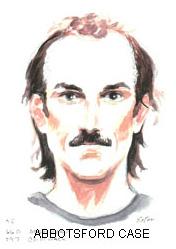
The case happened in 1995 and involved two young girls on their way home from a party late at night. While one girl was abducted, the other ran to safety at a hospital that just happened to be 100 yards away. The murder case had been going on for a few weeks, and studying the RCMP composite in the Vancouver newspaper I thought it was too basic, and was anatomically incorrect. This time it was an investigation by the local Abbotsford police, not the RCMP, and I thought I'd call the investigation and see if they would use me. So I phoned the Abbotsford Police and spoke with Inspector Rod Gehl who led the task force. He was interested enough to call Sacramento to verify my credentials. He called me back and asked me to help. So I was on board again, however, this case was to be one of the strangest outcomes. The case was solved, but not by the composite's accuracy. However, in another way I proved myself to be more professional than the RCMP artist. It turned out that the little girl was making up the slayers description. She was young and probably believed what she was describing, but the composites were both so far off that the killer decided to taunt the police with phone calls; and in doing so the police obtained a recording of his voice that identified him to the public, and of course the murderer was apprehended. His picture was released to the press and it looked nothing like either composite. Not even close.
I had been interviewed by the press several times during the investigation and of course they were very interested in why the composites were so far off track. The Vancouver Sun called me to ask for an interview but I declined. I did not want to harm the little girl, (my witness), so I immediately phoned Rod Gehl to ask for help. He said that he would make me a material witness and that would keep the press off me. Why in the world would I go and be interviewed, possibly damaging the witness even more. After all, witnesses can be used for more than their eye witness accounts, and she was damaged enough already. However, the RCMP police artist went ahead and took an interview with the newspaper claiming the little girl was delirious. To me it's only common sense to keep your mouth shut. I was never trained at the FBI academy; although I am mentioned in the text books at the academy. As an artist, you do not have the right to influence the witness. That's called tampering. What the RCMP artist did was damage his witness. He was not only a bad artist, but he also was willing to harm his witness's credibility to bolster his ego. My beef is only with the BC RCMP ID department.
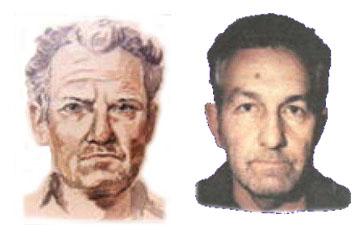
In Nanaimo a small city 70 miles above Victoria, I did do a good business in portraits, just not with the police. The fact is that when ever the local constables wanted to use me, I was never granted approval from the ID branch of RCMP headquarters. I often wonder how many people died because of (apparently) this job protection attitude. I introduced myself when a serial killer Clifford Olson was killing children. This was happening when I first introduced myself to the BC RCMP ID Department in Victoria, and the commanding inspector had promised me that I would be used when their artist was out of town. Shortly after this a constable wanted to use me to take an ID on the Olsen murder case. The ID department made the witness wait nine days till their artist was back from mid province to draw a composite. I'll leave it up to you as to why they made the witness wait. This was in 1980.
You might wonder how I left Sacramento in 1979 and ended up doing work on the I-5 Murders, Green River Task Force, and the Unabom Task Force. Simply, Sacramento after I left in 1979, wanted to find someone as good. I had moved to Salem, Oregon in 1982 thinking that maybe Canada wasn't my place. In the early 1980's there was ever rising interest on loans and I thought the local Canadian economy would have trouble feeding me. Before I moved to Salem, in May of 1980 to February of 1982, I worked at U-Frame-It, a franchise picture framing business in a mall, and the owners had me work in the front of the store as a draw to bring customers in.
I'm good at letting people watch me from over my shoulder, drawing portraits, and the people in the Vancouver Island city of Nanaimo had accepted my presence. After moving to Salem in 1982, I was having trouble building up a business. I was working in an old theater that had been converted to a walk through mall and there just wasn't enough business. Then after three months I started getting phone calls from the Nanaimo U-Frame-It manager telling me that there was business waiting for me if I'd move back. Realizing that it probably would take a great deal more time to establish myself in Salem, I decided I'd move back to Vancouver Island. So I loaded up the car and a U-haul truck and moved back to a small community near Nanaimo named Gabriola Island, a very beautiful place. The economy was on the mend and things got better.
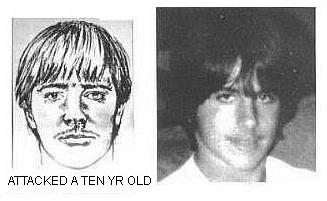
It was in November of 1982 when finally I got a call from Sacramento. There was a high profile case waiting for me if I was able to fly down. It had been three years since I left Sacramento, and I guess I won the battle of my importance with the detectives. Sacramento had not been able to find any artist to fill my shoes. When I arrived in Sacramento one of the investigators showed me a long list of names, and I had prevailed as the best artist, and on top of that the detectives were willing to fly me in from Canada for the job. But in accepting the job, I had to be interviewed by all the local news anchors, 20 minutes each, where I was given credit for my past police artwork. What a trip!
It was the first time I had been flown from Canada to work on a case, and it wasn't just the Sheriff's department that was paying for my appearance. Biondi was quite good at arranging support and had a travel agency donate my airline ticket and a hotel donate my room. I was the talk of the town that week, but I was now propped up on a pedestal and was under pressure to solve the case. It was a case that had been in the news for several weeks. I was to interview a 10 year old girl that had been left close to death by a rapist. The girl had been in a coma for 2½ weeks. She recovered and had a definite impression of her assailant. It would take me two interviews to do the composite. Newspaper article
It was in the paper the next day, but it took 6 weeks to get results. Here we get political again, and this is really what it's like for people in my shoes. Finally after six weeks, a man comes forward and tells investigators that he reluctantly thinks it's his son. Yes the investigators had looked high and low for someone who looked like the composite; but no one in Sacramento looked close to the composite, and after six weeks a man comes in and says it's his son. He told them that his son lived with his mom in San Diego and was up visiting the week of the incident. The father was apparently able to make a plea bargain with the district attorney, and Walla! the knowledge of the plea bargain is to be hidden from the press, and the man's son was to be put under observation. Today with FOX News, this would never happen. This decision was made to keep the little girl from going through a difficult trial. So in other words, I don't get public credit for my part in solving the case; and this was really a big solve for me. Of course I am famous with the little circle of investigators, but the people of Sacramento have no idea that I succeeded. Through the 1980's I was used on a handful of cases as well as Green River and Unabom, so I stay self employed mainly as a portrait artist working in a mall to feed my family. It was not an easy life.
In 1987 I had to visit Norco prison to take s description on the I-5 murder case, another interesting story, the only time I ever had to appear in a trial. The reason I was hired was to affirm the investigation that Sacramento's witness, who was incarcerated at Norco Prison for drug related charges, could identify the suspect who was due to be released. Sacramento Sheriffs Dept. Homicide had given two photo lineups to the witness prior to my use and investigators weren't positive enough of their witness to charge Roger Kibbe unless they could be certain the witness could perform successfully with a physical lineup. The investigation was having me extract a likeness so they could see what the witness had experienced when he and his girlfriend had been picked up by the killer. If the portrait was a close resemblance, they would arrest Kibbe. I made sure that I didn't know what Roger Kibbe looked like, nor did I have any mug shots or photographs of him with me. The composite was so close to Roger's Kibbe's physical identity that three years later I was put on the stand to clarify that I had not seen Kibbe or his photo before the composite was created. I had put the composite together from various feature album images and I had only used color mug shots of men in his age group, none being of him. What really is interesting is that in a Forensic Files episode about this crime, it is claimed that forensic evidence was presented and then Kibbe was arrested. The Forensic Files episode was claiming that forensic evidence did my job, but to my knowledge the evidence had not come back from the lab in time, and that is why I was used in the first place. What Hollywood will do to struggling artists like me to serve their needs. Believe me; I never would have been used if forensic evidence was at hand. This is just another effort by the media to steal my part in the investigation. Don't believe everything you read, or see on Forensic Files. But please do of course, believe me, and artist with very little political power.
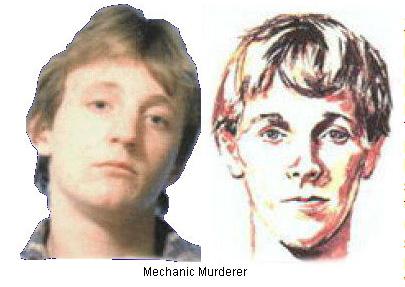
Also in 1987, I helped solve a case where a mechanic was murdered for his stash of money at home. The Mechanic didn't believe in banks and had something like forty thousand dollars stashed at his residence. I painted this composite right before I was sent to Salt Lake City to work with the UNABOM Task Force, which in looking at it can give you an idea of how close you can get in this line of work. The Unabom composite is not my best, but like stories for other investigations, the Unabom investigation is interesting. I really blame myself for not doing better, as I know for sure that I showed similar chins like Ted Kaczynski's to the witness. I was also asked to take the sunglasses off of the composite (if I could). At the time I regarded such a request a fantasy and not a right move. So I left the sunglasses on. Interesting is the fact that you can trace the perimeters of Ted's nose, mouth, and symmetry of the expression with the composite's. I should have insisted on more time with the witness. You don't want to push the witness too hard, and the objective is to recreate what the witness saw, lighting and view, without influencing or psychologically harming their memory. Now I know that sounds all right, but really, if you have a witness that is so fragile that you can influence and damage them, then think what the defense attorney will do to them. If you can harm a witness in that manner, then you do not have a witness. The same goes for witnesses picking out features to assemble a composite. If they can get mixed up, then you do not have a witness. Frankly, if a witness is sure that they can recognize the subject, then you have a witness, and you should be able to have them pick out features and assemble a good likeness.
I have done a number of composites over the years, but not anything like 75 or 100. You would think that I did them right and left. But I am a free agent and I only work when hired on a job basis. Yes, I have a great success rate, and it is due to the fact that I listen to my witness, and I know how to make them direct me in my drawings. I know how to make a nose long without drawing a freak. Everything changes when there are differences. You have to know your human dimensions so as you can understand a description. You have to use logic. For example, if you ask a person's age, you ask the witness to point out someone that looks the same age. If the witness looks at a facial feature shape and says no, then you have learned what it isn't. Sooner or later you know what it is. That is how it works. Oh, and you have to be very good and fast at drawing. I learned to draw like this by always having a sketchbook with me. I have done thousands of portraits (not police composites), and it makes me wonder when I hear that the chief or boss sent the best doodler in the department to be trained in a field such as this. If the boss was smart, they would go out and look for a willing artist that is already good in drawing. I'm Sorry if I offend people that have been selected as best in the department. But we are talking about a position where your skill level might mean saving a life. So go out and find a real artist. I think I have a right to be critical here, and damn the person that will argue because of a job protection attitude.
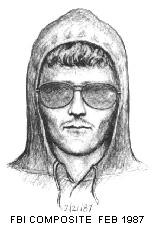
The UNABOM composite was first done in February of 1987 by an FBI department artist. SEE THE FBI Bulletin This was not a national release; in fact the witness requested the task force to find someone who could work in color. The reason that I was given the job was that Ray Biondi had a big part in the Unabom Task force. The first victim, Hugh Scrutton, had been murdered, blown apart in Sacramento in Ray's jurisdiction. Ray at that time was having me flown down from Canada on major cases. So thanks to Ray, I got to work over the FBI artist; and that is a real honor. Unfortunately, the composite would not bring the Unabomber in, nor did the forensic work by the ATF. The only thing that paid off was the decision to print the Unabomber's Manifesto, which in turn identified him to his brother. But it took 8 more years and two more deaths after his sighting in Salt Lake City.
There was a 6 year period of silence after the sighting, and then two bombs were delivered to targets on opposite shores delivered by the United States Postal Service. It was after these bombings in 1993 that the FBI took over the investigation from the ATF and US Postal Investigators.
The earlier Unabom Task Force had been comprised primarily of postal agents, ATF, and a couple FBI agents, but since the Unabomber had reappeared, the national pressure was on again. My major complaint was that no one in the new FBI Unabom Task Force knew I did the first release. For some reason, I wasn't important enough to locate and ask questions to. But I did know important details about the Salt Lake City sighting. For instance, one of the two female witnesses spied Ted walking across the parking lot described the Unabomber as having a nice bum and walked with a hop. He walked as if he used his toes to spring is motion forward. If a verbal description of this way of walking accompanied a good composite, it would narrow down the search somewhat. And another good reason for my discontent was a major mix-up between mine and the bomber's facial features. The new composite looked like me wearing a hooded sweat shirt more than the original description. My mother actually called me from California to tell me that she had seen my face on the cover of Newsweek.
Video: American Journal segment about the composite mix-up 1995
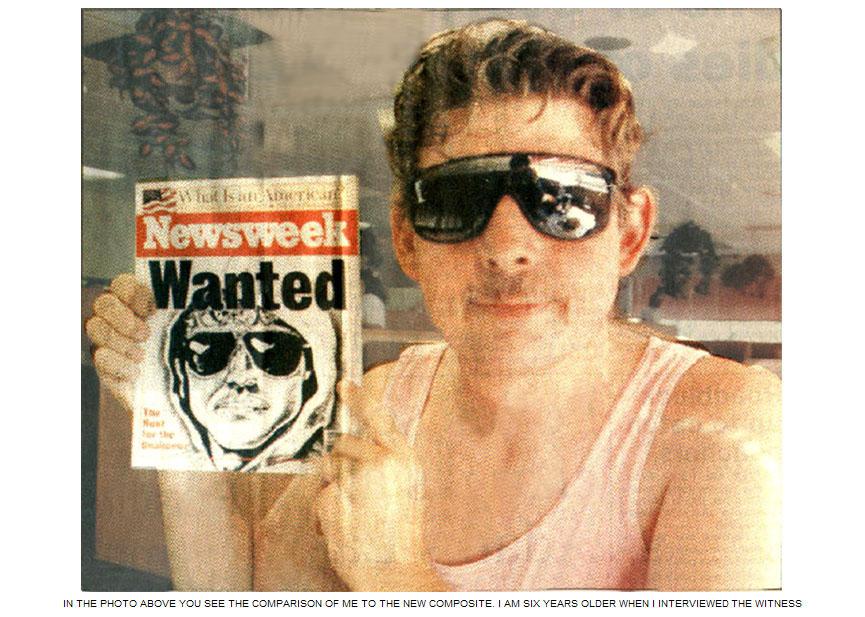
Look at the newspaper photograph of me holding the Newsweek magazine; The composite has a longer narrow nose, like mine. My nose was even thinner when I was 6 years younger and in this photo, the camera that took this picture from across a restaurant table causing a slightly distorted fish eye effect, meaning that I was even closer to the magazine image than this photo shows. The composite shows a taller upper clef above a wider mouth with fatter lips, all like on me, not like in the original 1987 composite. It was almost funny, and saddest of all was that the FBI had made no effort to be careful. All the movies you see emphasize that the FBI is so careful with evidence. If they had been careful, they would have called me, and I could have collaborated with their new artist and told her what not to do. I didn't care so much that they were using someone else as an artist. It was the sloppiness of not asking before changing things; the reckless decision of changing the composite without careful attention and analysis. This is really another example of investigators thinking that composites don't work. But there were some deadly accurate features in the first composite that could have been determined. In my professional opinion, I actually think we could have come up to a very close resemblance, I even was able to get the eyes right 1½ years before Ted Kaczynski was arrested. Truing up the composite with the witness should have been easy, and unfortunately I didn't have access to her. I can prove how some features were close and I knew the hair and chin was off a bit because the witness gave me that feeling, even when she said that she couldn't remember any more. I was even flown back from Canada to change the hair before the composite's release. Simply the witness was re used 6 years after the sighting, and instead of asking me what happened during my interviews, or what I knew, they just acted as if by magic they could hire a new artist and work with practically nothing. I will say this, the new composite had a squarer chin and I thought that to be the only change that was necessary. Every other facial feature took a blow. Please use your mouse by gliding it over the image below, and you will see how close the composite could have been by just placing the eyes, nose, and mouth in a composite I did in 1994 without the aid of the witness. My 1994 version is identical to the 1987 version with sunglasses except his eyes are exposed. The way I see it, if we had arrived at the Popeye chin and the lower hairline, and described his hop in his walk, I can see people in Montana calling the FBI.
I have been criticized for taking the sunglasses off, but let me explain to you why I thought it was important for the Unabom investigation to do; and to be fair to other critics, I told the investigators in 1987 that it wasn't ethical to remove them. If you are creating a composite, you are there to take a visual testimony from a witness. You do not want to draw anything but what they tell you to draw. And that is usually what should be done so that it is solely the witnesses visual statement. But with the situation of the witness seeing a man wearing a hooded sweatshirt with sunglasses you have to realize that a sighting like this would almost always be scrutinized by any defendant. So tactically, the investigation should try to expose the eyes, because a composite with dark sunglasses could look like too many people. And of course, you do not show this composite to the witness, you actually instruct the witness never to look at it. I do that in every interview. I always tell the witness not to look at the composite because the witness will start believing any mistakes I might have made. It is very important that the witness's memory is not compromised.
You might ask how I decided on the eyes? Simply, I compared the 1987 composite to thousands of mug shots I had on hand, analyzing the bone structure around the eye sockets. I came up with 127 mug shots and the eyes in all of them were basically the same shape. And you can see in the comparison below that I was right on.
Video: Exter appears on Worst Case Scenario
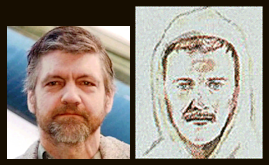
After seeing the new FBI composite in 1994, and seeing the obvious change in the face, let alone my own mother calling to tell me I looked like the new composite, I called investigators involved to warn them of what I thought was a wrong move. The next thing was that the press was notified of my observations and I was being called for interviews. This developed into a shooting match between the new artist and me. It was never my intention to attack her credibility. She insinuated that I was trying to get national attention; but I was only trying to warn the investigation of a wrong move. Simply the resemblance was too obvious to ignore. It was not a good year for my relationship with the FBI.
This is certainly a noteworthy study. To think that the witness could actually morph my face into her memory of the sighting. This situation developed into something that would make an interesting psychological study. If you were to ask someone you met on the street what time of day it was, most people would not be stimulated enough to remember a usable description. But if you are being robbed, you could easily remember the robbers face for a long time to come. That is the way our minds sort things out. The more stimulated a witness's memory is, the better the result will be.
The small credit I can claim is that I was the artist that created the 1987 composite. On April 26 1997, while watching Larry King Live, Tony Muljat, the lead U.S. Postal Inspector on the Task Force gave me a nice compliment. Below is from the show transcript, Arthur Kent was subbing for Larry King:
ARTHUR KENT: But the- the complexity - for instance, only one eyewitness in the entire 17 year train of events, and 16 bombings, only one eyewitness way back in 1987 in Salt Lake City.
TONY MULJAT: Mm-hm.
ARTHUR KENT: And then a six year- six year pause.
TONY MULJAT: Mm-hm.
ARTHUR KENT: Did it frighten you? The complexity and success with which this Unabomber was acting?
TONY MULJAT: Well, when we were fortunate to have a witness in Salt Lake in 1987, at that time, again, we didn't know if we were dealing with a male, female, a white male, black male - or whatever it was and- and that was a significant break for us at that time and then the composite that was provided by the eyewitness, in my opinion, was a strong likeness to the suspect and I think that drove him down under, I really do. You know, it-
TRANSCRIPT FROM LEXIS-NEXIS - LARRY KING LIVE - DECEMBER 9, 1997
In 2017 Discovery Channel used my material for the production of "Manhunt Unabomber". I noticed in the credits that Agent Fitzgerald was listed as a director which means this scene could very well have happened (or something close,, maybe actually showing the composite I did with eyes exposed)
Video: It was me Robert Exter, not Ted Kaczynski on Newsweek
It was said in the clip that it was a local artist. Not so, it was me. I was flown in from Vancouver Island BC, Canada. I'm a US vet but was living there as a landed immigrant. Sacramento investigators had missed me and when a high profile cases that would meet the expense for my travel, I would be flown in and used to do the work. The Unabomber's first victim was Hugh Scrutton, a computer store owner in Sacramento and homicide investigation was assigned to Ray Biondi's team. From that time on Ray was part of the Unabom task force and had a say in who might be used for a composite. This is not the total reason why I was used, the Salt Lake City witness requested an artist that could work in color and I had that qualification.
Videos of interest:
If you would like to see police composite art in action, here is an eight minute clip from a 2003 episode of Worst Case Scenario where I and another police artist are set up with four witnesses unaware that they will be used to describe a suspect running by. Please read the opening page before you view the video. video of Police Art in Action
American Journal interview in 1995: video interview American Journal Unabomber_.avi
Investigators, please read: Ray Biondi retired with an excellent solve rate, meaning that he had an excellent team of investigators. I was his police artist but I lived in Canada, and this meant that a key element was gone that gave me the opportunity to use my talents in the United States. But since Ray’s retirement I have moved back to California and have been developing a way to interview witnesses over an internet connection. How it works is simple: All I needed to interview a witness is a feature sample book, a sketch pad, a pencil, and myself. Today, using an internet connection, interviewing a witness is not only possible, but more practical. I have created an on line a kit, and using internet search engines, there is access to images of anything imaginable. The witness only needs an internet connection and a phone line. Also, with broadband and an up to date computer capable of audio and video conferencing, you don’t even need a phone. It actually is much better than flying me to an interview because everything can be recorded and documented, revealing what happened during the interview to investigators, and simplifying the adjudication process. If you are an investigator and would like to use my services, please contact me and I will give you the address to my witness interview website.
Robert Exter
Portrait and Police Artist
Phone: (530) 221-4462
If you are not an investigator and would like to help me in my efforts, below are some ways to do this:
-
If you would like to help my efforts in some way, then please go to the Unabom Artistore
-
Remember that I am a portrait artist and can be commissioned. If you would like to commission a portrait, this can be done also by contacting me: Inquiring about a commissioned portrait Examples on display at www.robertexter.com
-
If you have anything to add, or comments to make, please write me: robertexter@gmail.com
